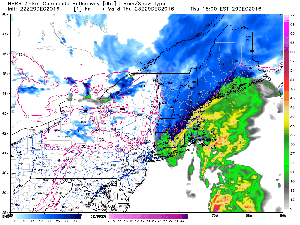Dynamic Cooling: Occurs when strengthening storms produce strong upward motion and heavy precipitation that cools the atmosphere. The cooling happens because of two things. First, rising air cools as it becomes surrounded by a cooler environment and is further removed from the source of heat (sun-warmed surface objects). Second, heavy frozen precipitation falling into a warm layer will result in latent heat being transferred from the air to the melting hydrometeors so that a phase change (solid to liquid) can occur. The net loss of heat energy in the air will cause it to cool.

Look for dynamic cooling when there is lots of upward motion in areas with heavy precip on the NW flank of a storm. Dynamic cooling can be strong enough to transition synoptic scale areas from liquid to frozen precipitation especially in the absence of strong warm thermal advection though if the dynamic cooling effect is greater than the thermal advection, a change from rain to snow can occur even in a warm air advection regime.
For a great example of dynamic cooling, check out my post on a rapidly intensifying storm system that occurred just after Christmas of 2016 and featured some intense dynamic cooling.
-Jack

One thought on “Dynamic Cooling”